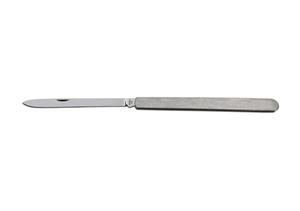Tasting knife
26. srpna 2024
Are you a gourmet? Do you love food and like to test new flavours? Is it important to you that the food you taste is as little damaged and contaminated as possible during such testing? Then you need a tasting knife with a typically long and narrow blade that allows you to easily penetrate, for example, a piece of cheese or butter. And Mikov hasn't forgotten you, of course.

Tasting knives as we know them today began to appear in the 19th and 20th centuries with the development of the food industry and the increased emphasis on quality and specialisation in gastronomy. They are used not only in cheese factories and wine cellars, but also in restaurants and in gastronomic competitions where experts evaluate and compare different products. And because Mikov produces professional kitchen and butchery knives, it also produces a tasting knife with the trade name Appet.
Every tool must be used correctly. That's why Mikov has prepared, for example, instructions on how to sharpen knives or how to use a knife sharpener. Thus, even tasting with a tasting knife involves several key steps to ensure that the tasting is carried out hygienically and safely, allowing you to fully appreciate the quality of the product being tasted.
- Make sure the tasting knife is clean and dry. If you are tasting several products, start with the one that has the least intense flavour so that the most intense one does not overpower the others.
- Cut off a small piece. If you are tasting cheese, try to sample from different parts of the cheese (centre, edge) to get a full picture of the flavour and texture.
- Examine the sample on the knife. Note the colour, texture and any signs of ageing or fermentation. Smell the sample directly on the knife. Smell is a key element in tasting, as many taste sensations are actually perceived through the sense of smell.
- Carefully place the sample in your mouth and allow it to slowly dissolve on your tongue. Notice how the taste and texture develop. Consider the complexity, balance and maturation of the flavour.
- After tasting each product, clean the knife to ensure that no previous flavors contaminate the next tasting.
Tasting with a tasting knife is an art that allows you to delve deeper into the mystery of flavours. That's why every step is important, from selecting the sample to tasting it. Mikov has prepared the optimum tool for this and wishes you an appropriately delicate palate and sense of smell.
